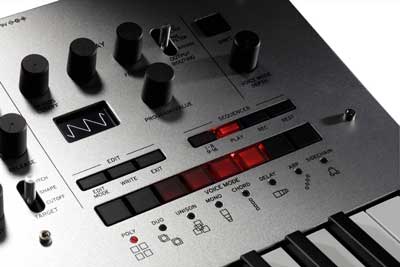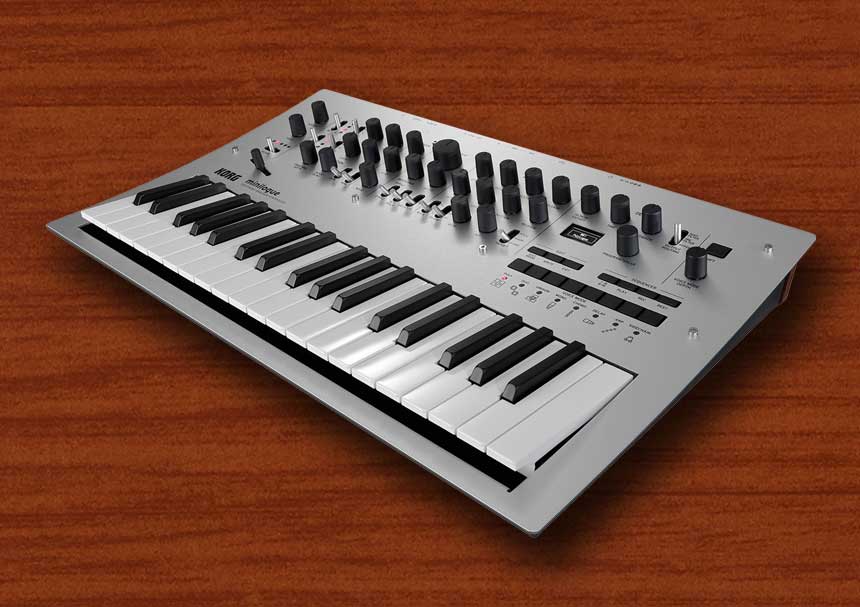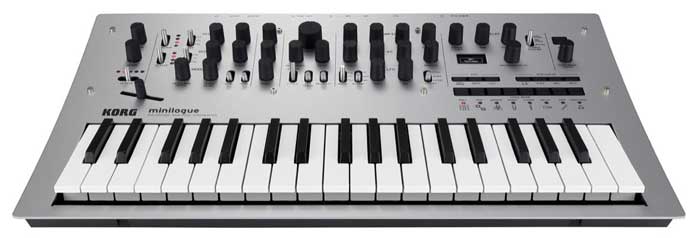2016 is set to be a good year for analog synthesis if recent releases from companies like Arturia, Dave Smith and Korg are any indication. While Roland recently paid homage to their rich history of synth design with their analog-modeling Boutique synth line, Korg is looking to the future with the new minilogue. Unlike the similarly priced microKORG, the minilogue is a true analog synth, using analog oscillators to generate a signal. Fans of Korg’s Volca units, the super-affordable analog mini groove boxes, may want to check out the minilogue as a step up from the Volca series in features, sound quality, and build.
The minilogue is a four-voice polysynth with 200 presets, several voice modes (more on those later), a tape-style delay, a 16-step sequencer, MIDI and CV in and out, all inside a sand-blasted aluminum enclosure with a wooden back panel. What’s not to like?
Continuing the comparison with the microKORG, all of the synth parameters on the minilogue are controllable by the knobs and switches on the front panel, meaning you will never have to go digging through endless menus to tweak sounds. The microKORG on the other hand is much more menu-intensive, and while its analog-modeling (digital) nature does give it more flexibility in sound generation, many die-hard synth aficionados insist that nothing sounds quite like analog. The benefits of having everything right in front of you and controllable by physical knobs become obvious as you start to explore all the modulation possibilities the minilogue has to offer. With cross modulation, oscillator sync, a ring modulator, and even a delay with a high-pass filter, things can get crazy quickly and having instant, easy control is key.
Now on to the voice modes. The minilogue has eight different voice modes which control how and when the oscillators are triggered. The “Poly” mode operates as a 4-voice polysynth with individual control over all 4 voices. “Duo,” “Mono,” and “Unison” are ARP– and Moog-like single and dual voice modes. The “Chord” mode is a potentially very useful feature, especially for non-keyboardists who want to use this synth, as it plays whole chords when a single key is pressed, and the chord types are altered by turning the “Voice Mode Depth” knob, which selects through most common chord types. The “Arp” is a 4-voice arpeggiator and the “Delay” and “Sidechain” modes produce interesting ducking and sliding type effects. On settings other than “Chord,” the Voice Mode Depth knob controls the amount of oscillator detuning, for thick, chorus-y effects.
As if this weren’t enough for the diminutive little synth, it also includes a 16-step sequencer which can accept input via step, real-time recording, and overdubbing. Adjustments to any of the minilogue’s controls are also sequenced, allowing for very detailed sequencing. The minilogue also gives you a readout of the real-time waveform you are generating via a built in OLED display. Aside from being just plain fun to watch while you’re playing, this waveform gives you additional information about the sound you’re shaping, and helps you see how the shape of the waveform you’re generating is affecting the tone and timbre, in real time.
Add to all this the fact that you can sync the minilogue to Korg’s other groove machines (such as the Volca series, an Electribe or SQ-1) or any other CV or MIDI sync-capable devices and it’s easy to see how the minilogue is a fun and affordable creation machine, usable by almost anyone. But the real value is that Korg has managed to put 4 analog oscillators in a fully-functional, great sounding synth that includes a sequencer, arpeggiator, and MIDI/CV in/out. Aside from possibly an overdrive/distortion type knob (a la Arturia’s MiniBrute), it’s hard to see what else could have been included here: this affordable little board is pretty feature packed and Korg’s oscillators have a good amount of growl to them already.






Leave a Reply